Energy Efficiency of Microwave-Induced Heating of Crushed Rocks/Ores
Abstract
:1. Introduction
2. Methodology
2.1. Materials and Methods
2.1.1. Material Properties
2.1.2. Microwave Treatment
2.2. Numerical Modelling
- The domain was source-free;
- The initial electric field and magnetic flux density were set to zero (E0 and B0);
- The initial temperature of the samples and cavity before microwave exposure () was set to 293.15 K (20 °C);
- The rock/ore was isotropic and homogeneous;
- The time-harmonic Maxwell’s equations were solved owing to the periodicity of the electromagnetic field (TE10 excitation mode);
- The waveguide and cavity surfaces were considered perfect electric conductors;
- Heat dissipation to the encompassing domain was considered by incorporating convective heat transfer boundary conditions.
3. Results and Discussion
4. Conclusions
Author Contributions
Funding
Conflicts of Interest
References
- Lin, B.; Zhu, R. How does market-oriented reform influence the rebound effect of China’s mining industry? Econ. Anal. Policy 2022, 74, 34–44. [Google Scholar] [CrossRef]
- Nadolski, S.; Klein, B.; Kumar, A.; Davaanyam, Z. An energy benchmarking model for mineral comminution. Miner. Eng. 2014, 65, 178–186. [Google Scholar] [CrossRef]
- Walkiewicz, J.; Kazonich, G.; McGill, S. Microwave heating characteristics of selected minerals and compounds. Miner. Metall. Process. 1988, 5, 39–42. [Google Scholar]
- Klein, B.; Wang, C.; Nadolski, S. Energy-Efficient Comminution: Best Practices and Future Research Needs. In Energy Efficiency in the Minerals Industry: Best Practices and Research Directions; Awuah-Offei, K., Ed.; Springer International Publishing: Cham, Switzerland, 2018; pp. 197–211. [Google Scholar]
- Rumpf, H. Physical aspects of comminution and new formulation of a law of comminution. Powder Technol. 1973, 7, 145–159. [Google Scholar] [CrossRef]
- Fitzgibbon, K.; Veasey, T. Thermally assisted liberation—A review. Miner. Eng. 1990, 3, 181–185. [Google Scholar] [CrossRef]
- Pocock, J.; Veasey, T.; Tavares, L.; King, R. The effect of heating and quenching on grinding characteristics of quartzite. Powder Technol. 1998, 95, 137–142. [Google Scholar] [CrossRef]
- Whittles, D.; Kingman, S.; Reddish, D. Application of numerical modelling for prediction of the influence of power density on microwave-assisted breakage. Int. J. Miner. Process. 2003, 68, 71–91. [Google Scholar] [CrossRef]
- Koleini, S.J.; Barani, K. Microwave Heating Applications in Mineral Processing; InTech: London, UK, 2012. [Google Scholar]
- Ford, J.; Pei, D. High temperature chemical processing via microwave absorption. J. Microw. Power 1967, 2, 61–64. [Google Scholar] [CrossRef]
- Chen, T.; Dutrizac, J.; Haque, K.; Wyslouzil, W.; Kashyap, S. The relative transparency of minerals to microwave radiation. Can. Metall. Q. 1984, 23, 349–351. [Google Scholar] [CrossRef]
- Haque, K.E. Microwave energy for mineral treatment processes—A brief review. Int. J. Miner. Process. 1999, 57, 1–24. [Google Scholar] [CrossRef]
- Kingman, S.W.; Jackson, K.; Bradshaw, S.; Rowson, N.; Greenwood, R. An investigation into the influence of microwave treatment on mineral ore comminution. Powder Technol. 2004, 146, 176–184. [Google Scholar] [CrossRef]
- Walkiewicz, J.W.; Clark, A.E.; McGill, S.L. Microwave-assisted grinding. IEEE Trans. Ind. Appl. 1991, 27, 239–243. [Google Scholar] [CrossRef]
- Tavares, L.; King, R. Effect of Microwave-Induced Damage on Single-Particle Comminution of Ores; Society of Mining Engineers of AIME: Englewood, CO, USA, 1996. [Google Scholar]
- Kingman, S.; Corfield, G.; Rowson, N. Effects of microwave radiation upon the mineralogy and magnetic processing of a massive Norwegian ilmenite ore. Magn. Electr. Sep. 1999, 9, 131–148. [Google Scholar] [CrossRef]
- Kingman, S.W.; Vorster, W.; Rowson, N. The influence of mineralogy on microwave assisted grinding. Miner. Eng. 2000, 13, 313–327. [Google Scholar] [CrossRef]
- Wang, Y.; Forssberg, E.; Svensson, M. Microwave assisted comminution and liberation of minerals. In Mineral Processing on the Verge of the 21st Century; Routledge: London, UK, 2000; pp. 3–9. [Google Scholar]
- Jones, D.A.; Kingman, S.; Whittles, D.; Lowndes, I. Understanding microwave assisted breakage. Miner. Eng. 2005, 18, 659–669. [Google Scholar] [CrossRef]
- Jones, D.; Kingman, S.; Whittles, D.; Lowndes, I. The influence of microwave energy delivery method on strength reduction in ore samples. Chem. Eng. Process. Process Intensif. 2007, 46, 291–299. [Google Scholar] [CrossRef]
- Ali, A.; Bradshaw, S. Bonded-particle modelling of microwave-induced damage in ore particles. Miner. Eng. 2010, 23, 780–790. [Google Scholar] [CrossRef]
- Ali, A.; Bradshaw, S. Quantifying damage around grain boundaries in microwave treated ores. Chem. Eng. Process. Process Intensif. 2009, 48, 1566–1573. [Google Scholar] [CrossRef]
- Wei, W.; Shao, Z.; Zhang, Y.; Qiao, R.; Gao, J. Fundamentals and applications of microwave energy in rock and concrete processing–A review. Appl. Therm. Eng. 2019, 157, 113751. [Google Scholar] [CrossRef]
- Ahmadihosseini, A.; Shadi, A.; Rabiei, M.; Samea, P.; Hassani, F.; Sasmito, A.P. Computational study of microwave heating for rock fragmentation; model development and validation. Int. J. Therm. Sci. 2022, 181, 107746. [Google Scholar] [CrossRef]
- Ahmed, H.M.; Ahmadihosseini, A.; Hassani, F.; Hefni, M.A.; Ahmed, H.M.; Saleem, H.A.; Moustafa, E.B.; Sasmito, A.P. Numerical and experimental analyses of rock failure mechanisms due to microwave treatment. J. Rock Mech. Geotech. Eng. 2023, in press. [CrossRef]
- Deyab, S.M.; Ahmadihosseini, A.; Rafezi, H.; Hassani, F.; Sasmito, A.P. Investigating Microwave Treatment of Rocks Based on Fracture Mechanics Analysis in Mode I Fracture Toughness Test. Rock Mech. Rock Eng. 2023, 56, 5275–5291. [Google Scholar] [CrossRef]
- Toifl, M.; Hartlieb, P.; Meisels, R.; Antretter, T.; Kuchar, F. Numerical study of the influence of irradiation parameters on the microwave-induced stresses in granite. Miner. Eng. 2017, 103, 78–92. [Google Scholar] [CrossRef]
- Toifl, M.; Meisels, R.; Hartlieb, P.; Kuchar, F.; Antretter, T. 3D numerical study on microwave induced stresses in inhomogeneous hard rocks. Miner. Eng. 2016, 90, 29–42. [Google Scholar] [CrossRef]
- Xue, Y.; Zheng, C.; Dang, F.; Ma, Z.; Gao, J. Numerical simulation of damage and permeability evolution mechanism of coal seam under microwave radiation. Therm. Sci. 2019, 23 Pt A, 1355–1361. [Google Scholar] [CrossRef] [Green Version]
- Zhu, J.; Yi, L.; Yang, Z.; Duan, M. Three-dimensional numerical simulation on the thermal response of oil shale subjected to microwave heating. Chem. Eng. J. 2021, 407, 127197. [Google Scholar] [CrossRef]
- Xu, T.; He, L.; Zheng, Y.; Zou, X.; Badrkhani, V.; Schillinger, D. Experimental and numerical investigations of microwave-induced damage and fracture formation in rock. J. Therm. Stress. 2020, 44, 513–528. [Google Scholar] [CrossRef]
- Ali, A.; Bradshaw, S. Confined particle bed breakage of microwave treated and untreated ores. Miner. Eng. 2011, 24, 1625–1630. [Google Scholar] [CrossRef]
- Rabiei, M.; Samea, P.; Shadi, A.; Ghoreishi-Madiseh, S. A Discrete Element Analysis for General Failure Behavior of Basalt. Int. J. Rock Mech. Min. Sci. 2022, 167, 105394. [Google Scholar] [CrossRef]
- Lu, G.-M.; Li, Y.-H.; Hassani, F.; Zhang, X. The influence of microwave irradiation on thermal properties of main rock-forming minerals. Appl. Therm. Eng. 2017, 112, 1523–1532. [Google Scholar] [CrossRef]
- Hutcheon, R.; de Jong, M.; Adams, F. A system for rapid measurements of RF and microwave properties up to 1400 °C. Part 1: Theoritical development of the cavity frequency-shift data analysis equations. J. Microw. Power Electromagn. Energy 1992, 27, 87–92. [Google Scholar] [CrossRef]
- Hutcheon, R.; de Jong, M.; Adams, F. A System for Rapid Measurements of RF and Microwave Properties Up to 1400 °C. Part 2: Description of Apparatus, Data Collection Techniques and Measurements on Selected Materials. J. Microw. Power Electromagn. Energy 1992, 27, 93–102. [Google Scholar] [CrossRef]
- Hassani, F.; Shadi, A.; Rafezi, H.; Sasmito, A.P.; Ghoreishi-Madiseh, S.A. Energy analysis of the effectiveness of microwave-assisted fragmentation. Miner. Eng. 2020, 159, 106642. [Google Scholar] [CrossRef]
- Ãzisik, M.N. Heat Conduction; John Wiley & Sons: Hoboken, NJ, USA, 1993. [Google Scholar]
- Hayt, W.H.; Buck, J.A. Engineering Electromagnetics; McGraw-Hill: New York, NY, USA, 1981; Volume 6. [Google Scholar]
- Motlagh, P.N. Physical and Mechanical Properties of Rocks Exposed to Microwave Irradiation: Potential Application to Tunnel Boring; McGill University: Montreal, QC, Canada, 2015. [Google Scholar]
- Gupta, A.; Yan, D.S. Mineral Processing Design and Operations: An Introduction; Elsevier: Amsterdam, The Netherlands, 2016. [Google Scholar]
- Shadi, A.; Ahmadihosseini, A.; Rabiei, M.; Samea, P.; Hassani, F.; Sasmito, A.P.; Ghoreishi-Madiseh, S.A. Numerical and experimental analysis of fully coupled electromagnetic and thermal phenomena in microwave heating of rocks. Miner. Eng. 2022, 178, 107406. [Google Scholar] [CrossRef]
- Gunn, D. Transfer of heat or mass to particles in fixed and fluidised beds. Int. J. Heat Mass Transf. 1978, 21, 467–476. [Google Scholar] [CrossRef]
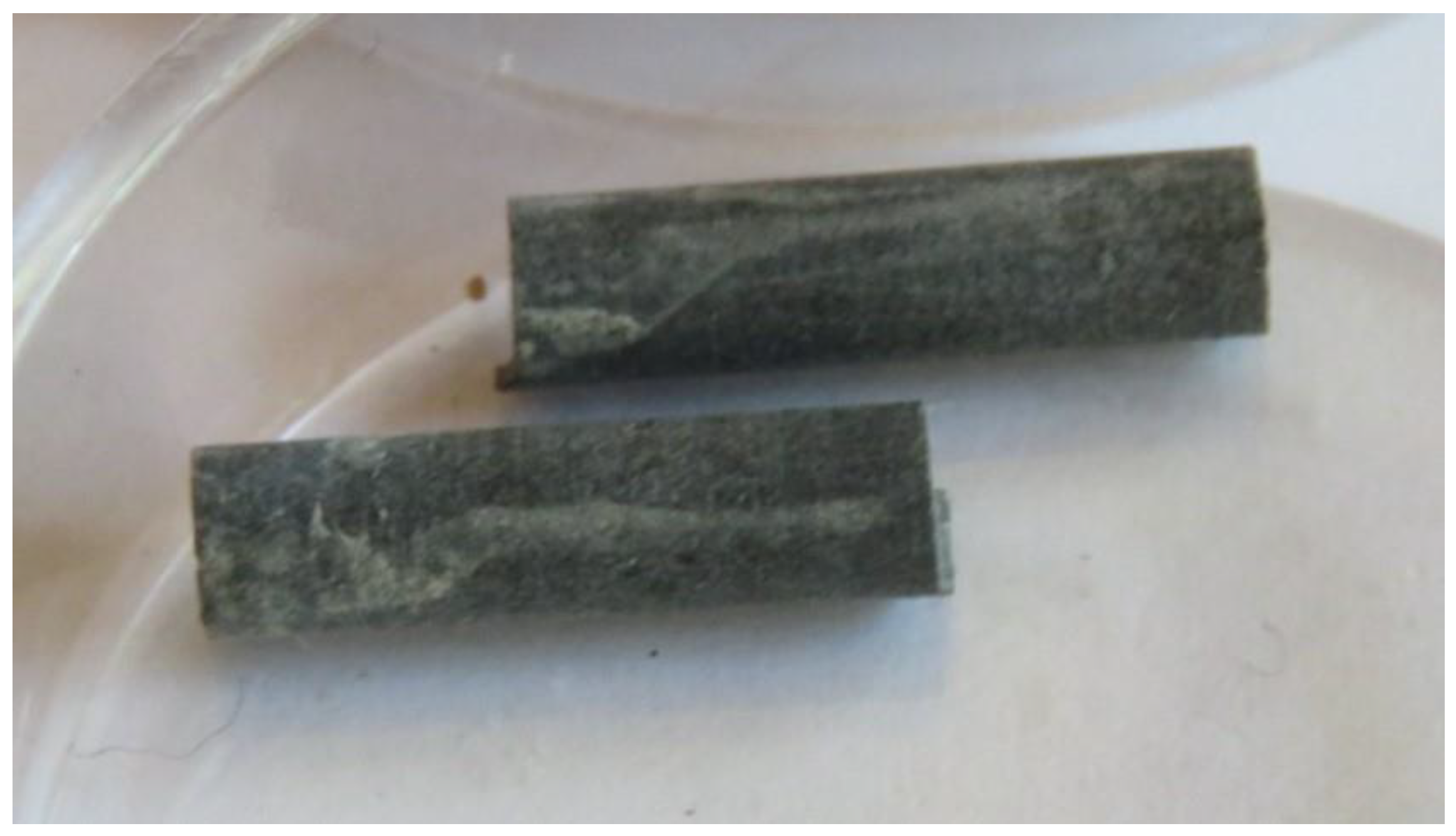
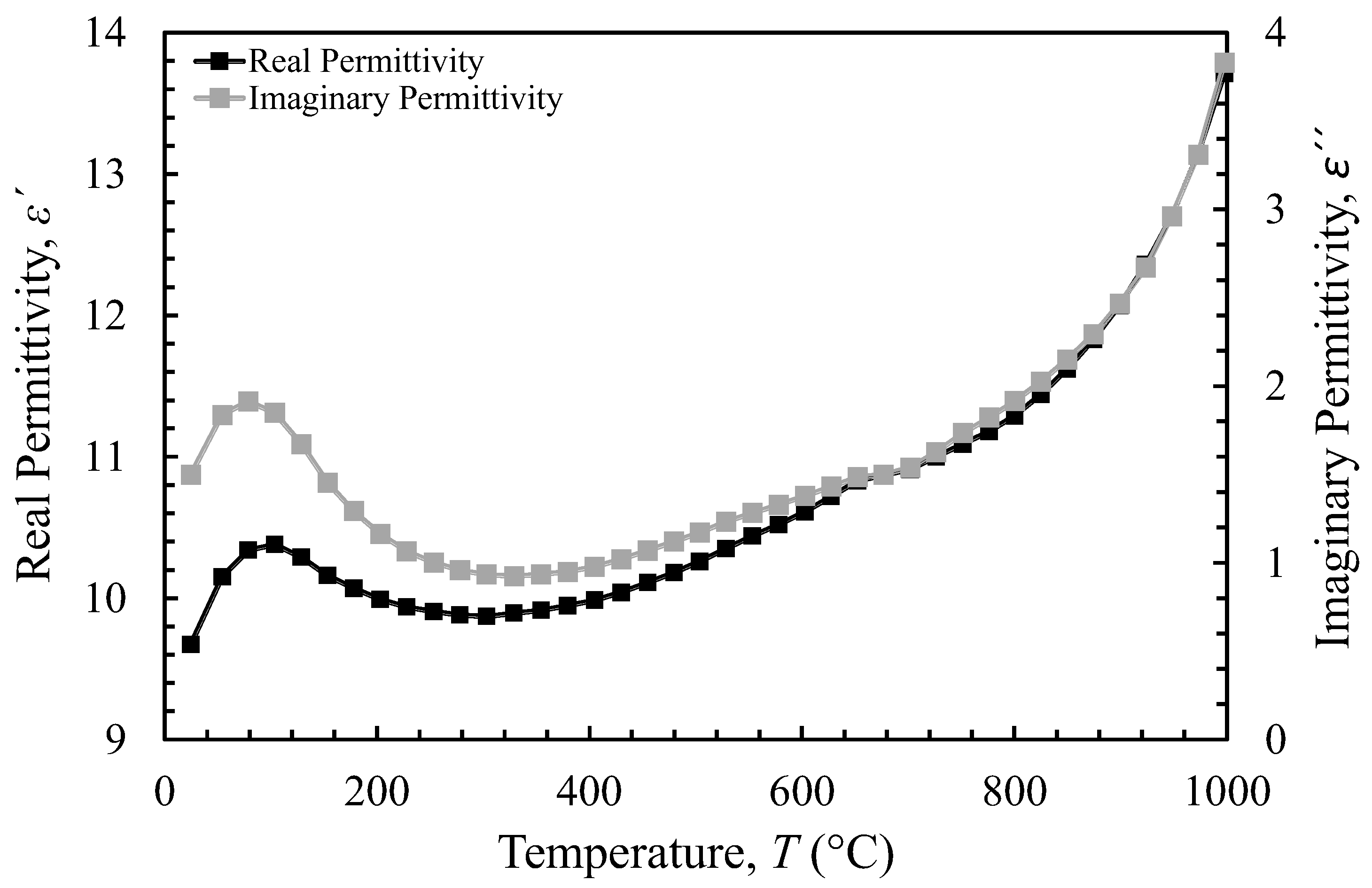
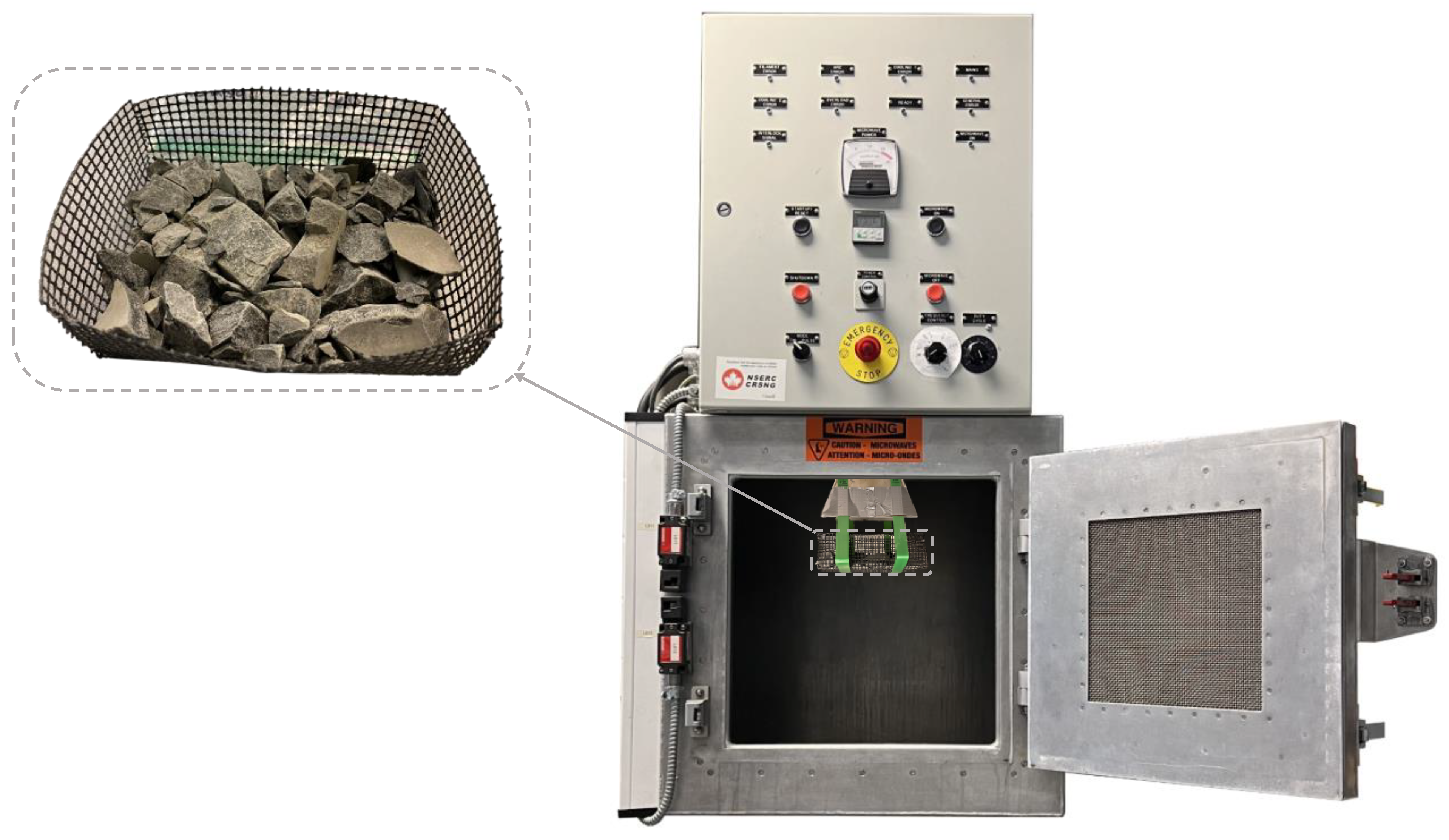
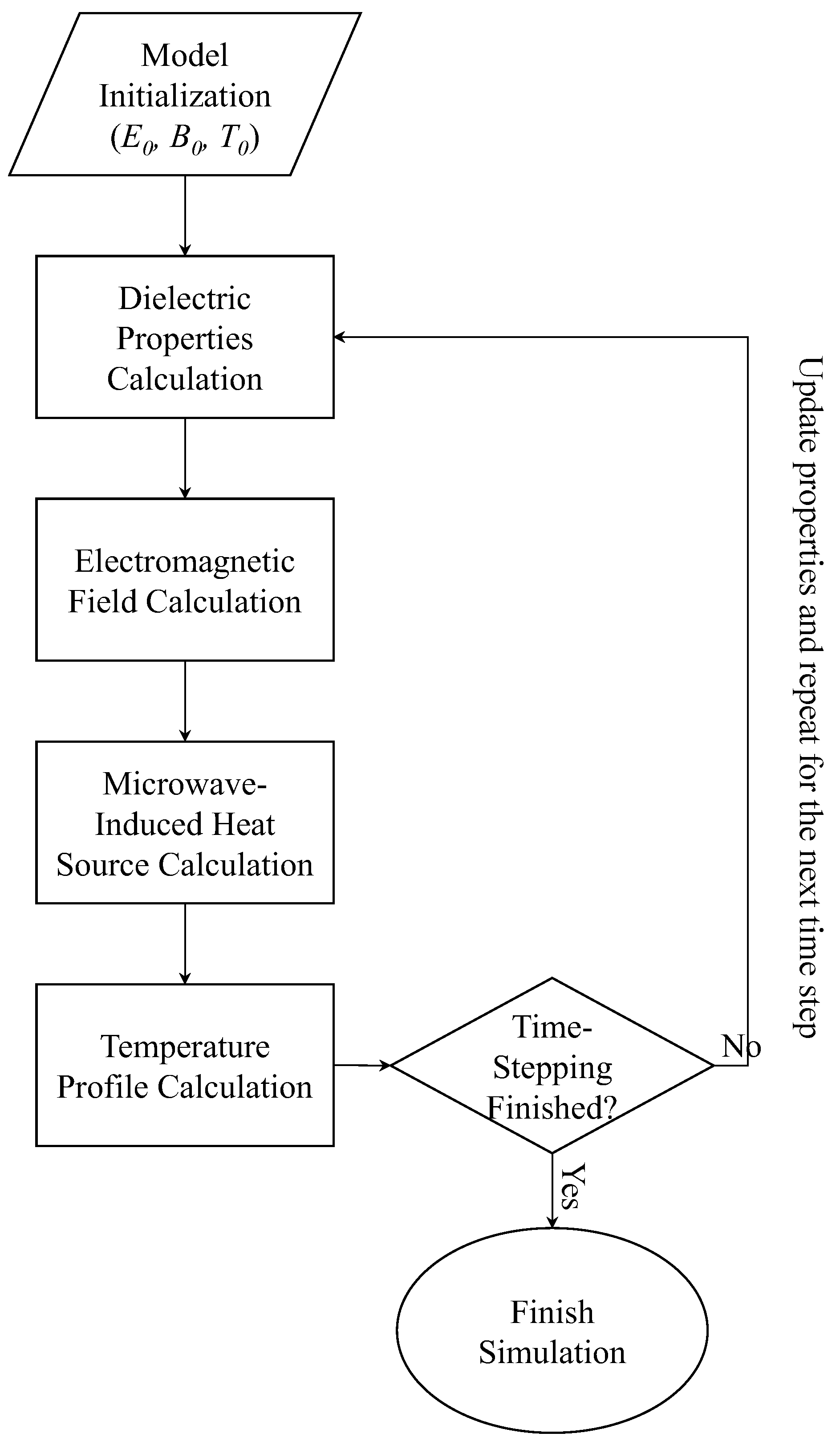
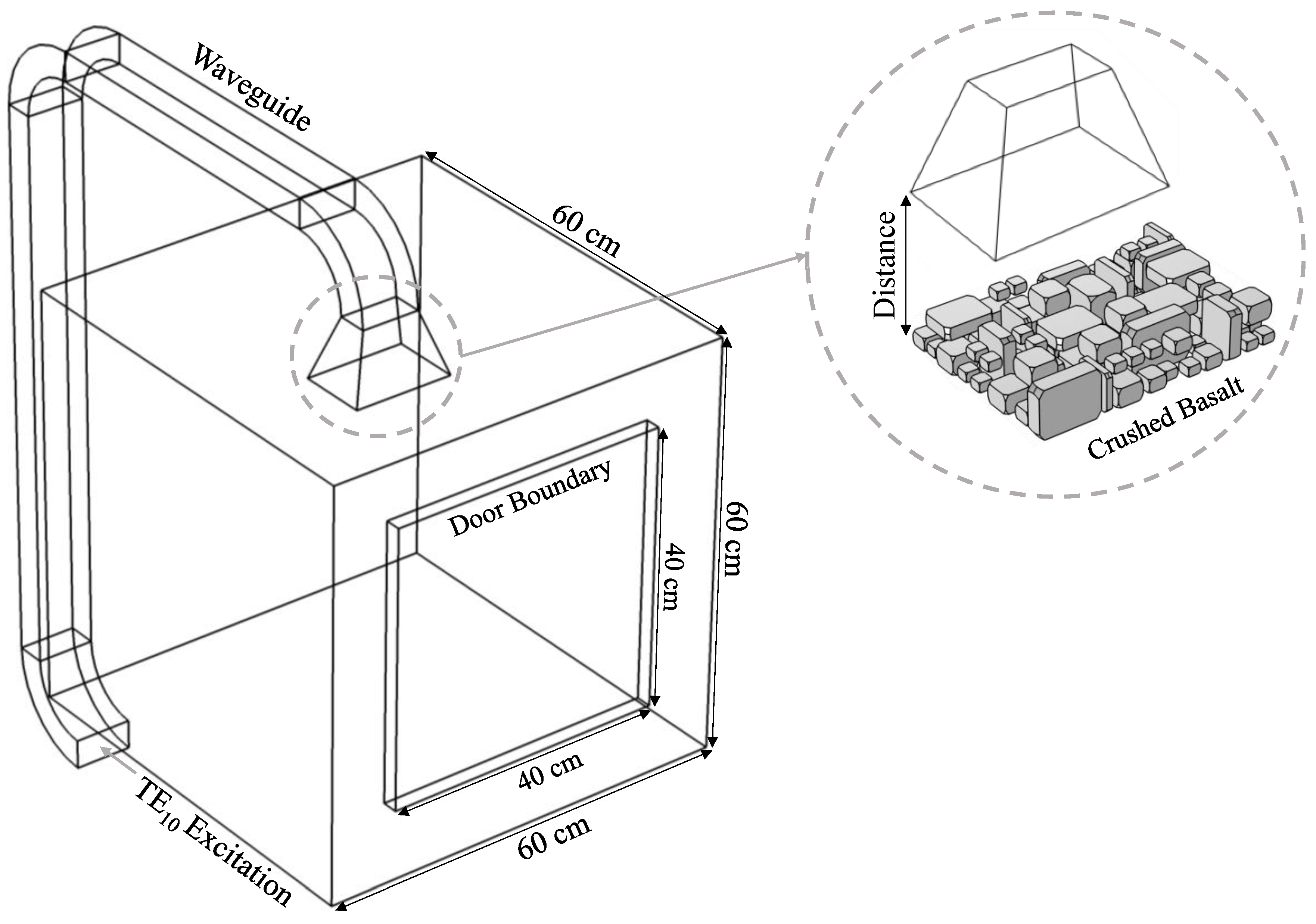
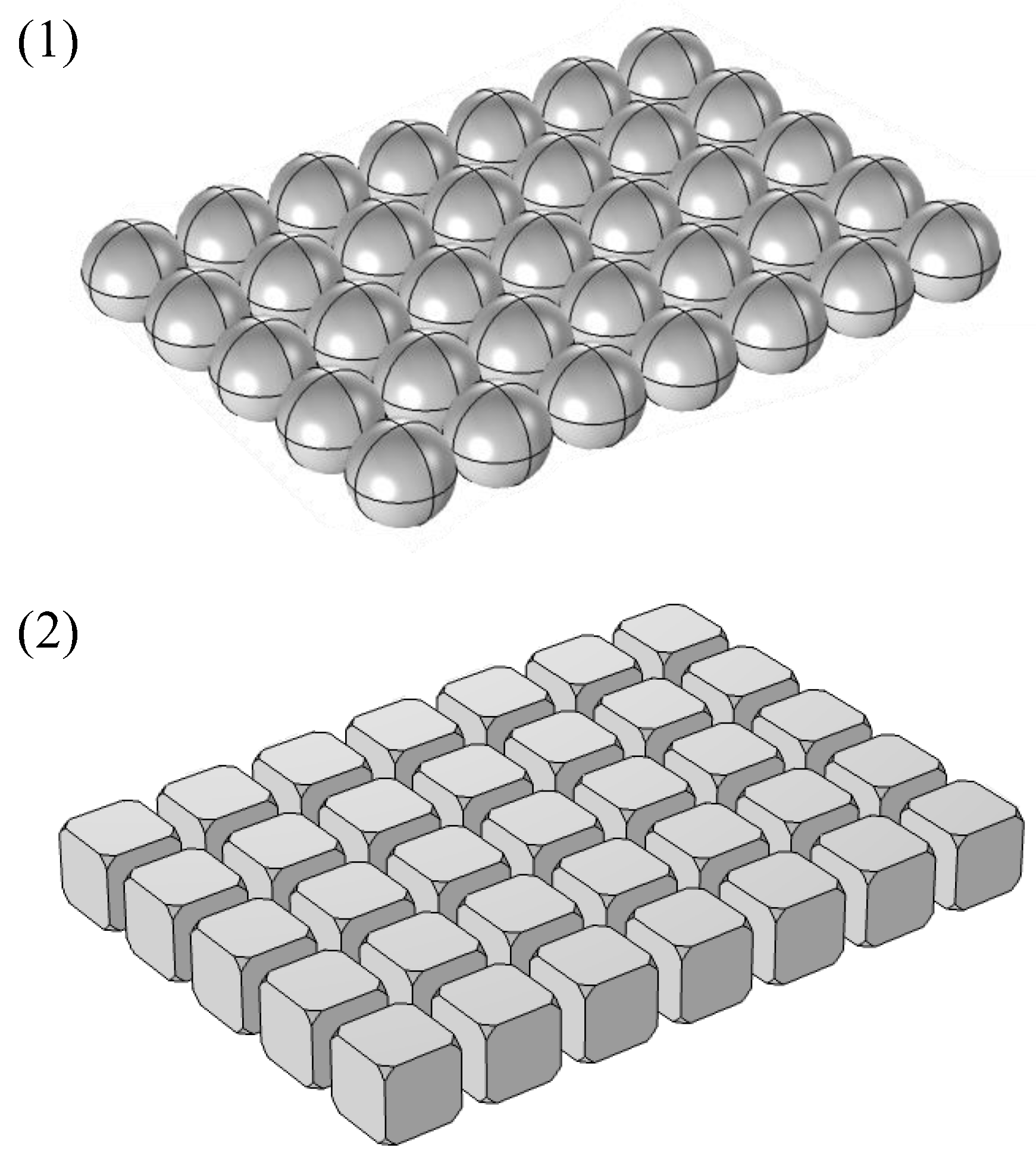
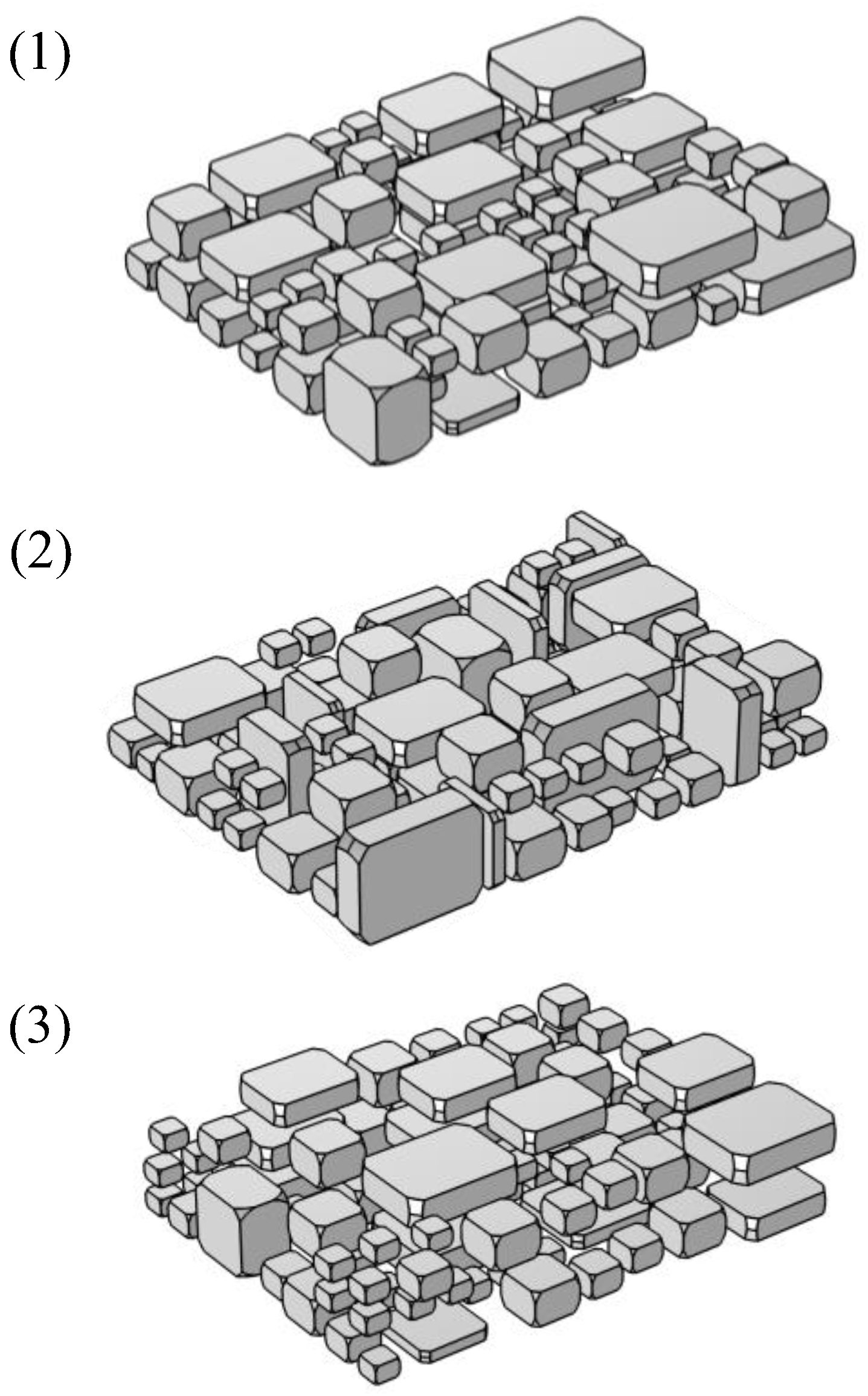
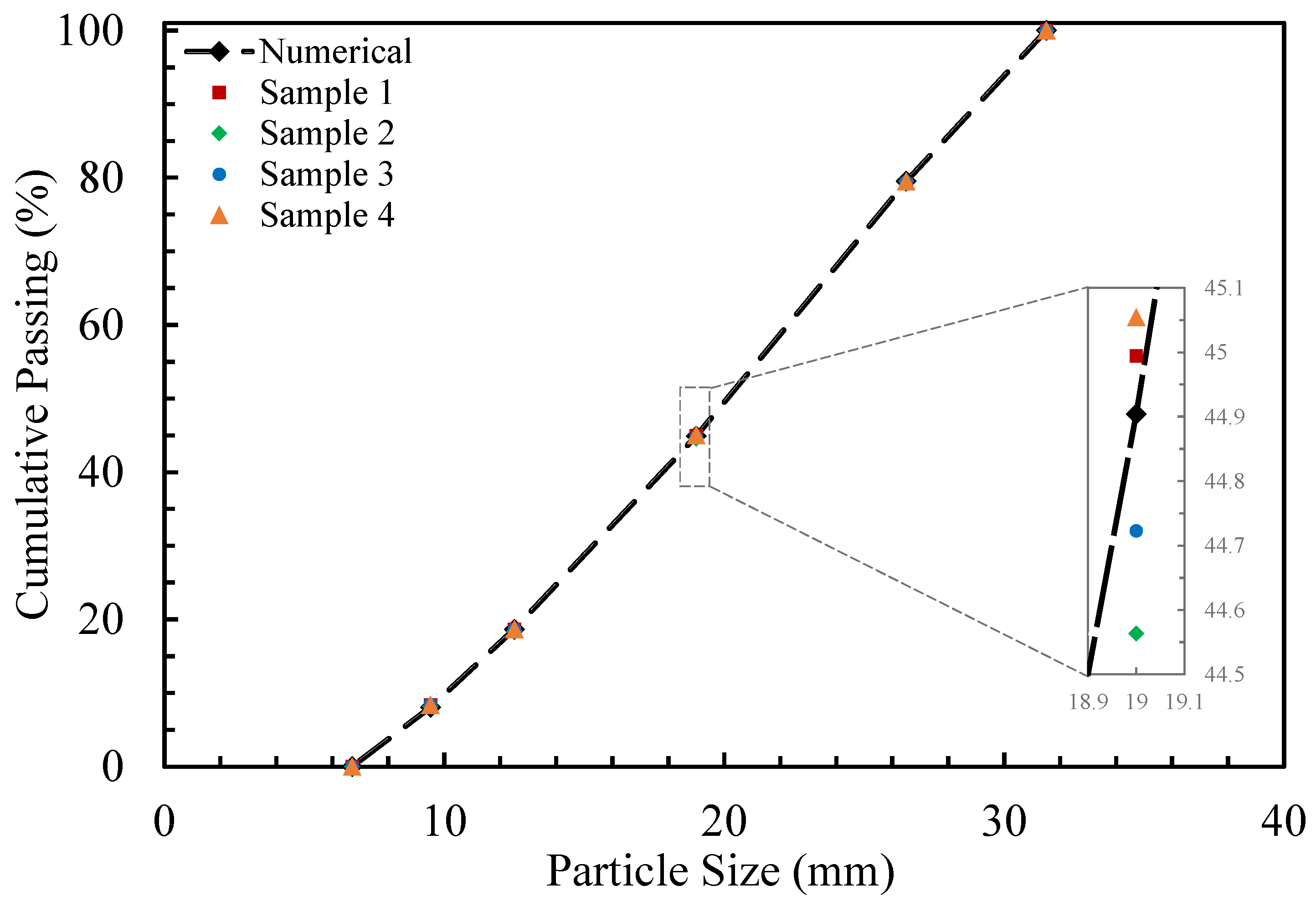

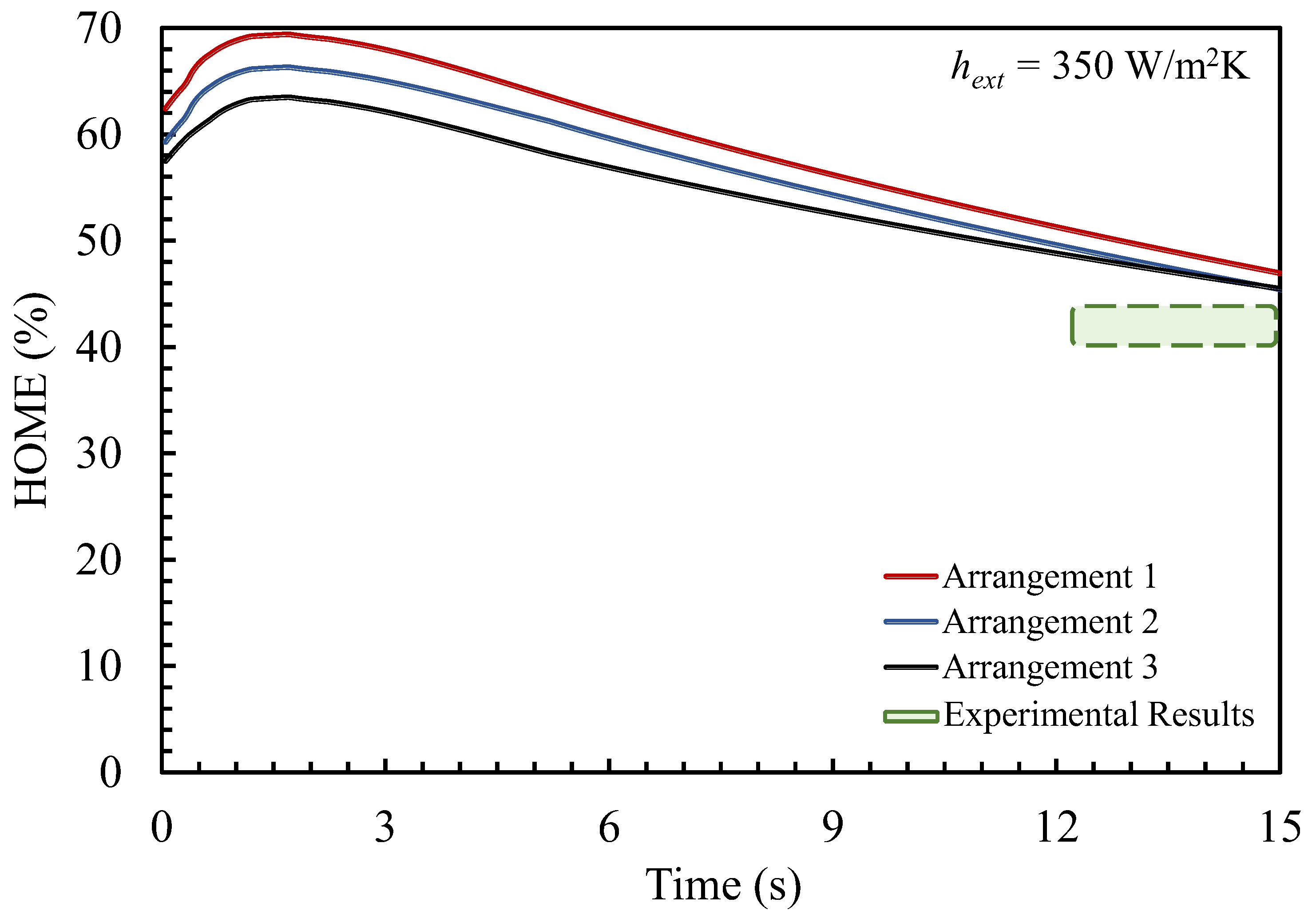
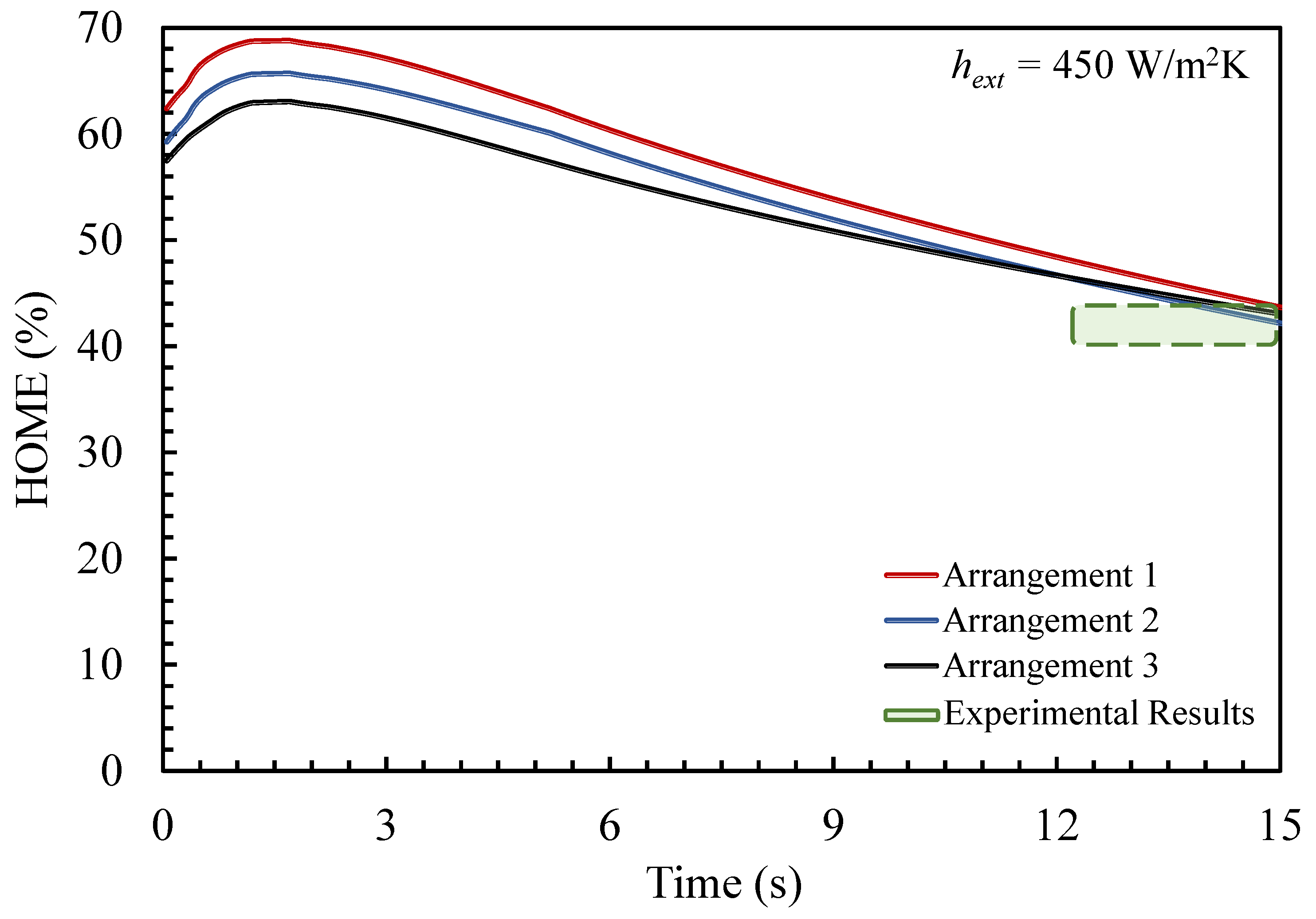
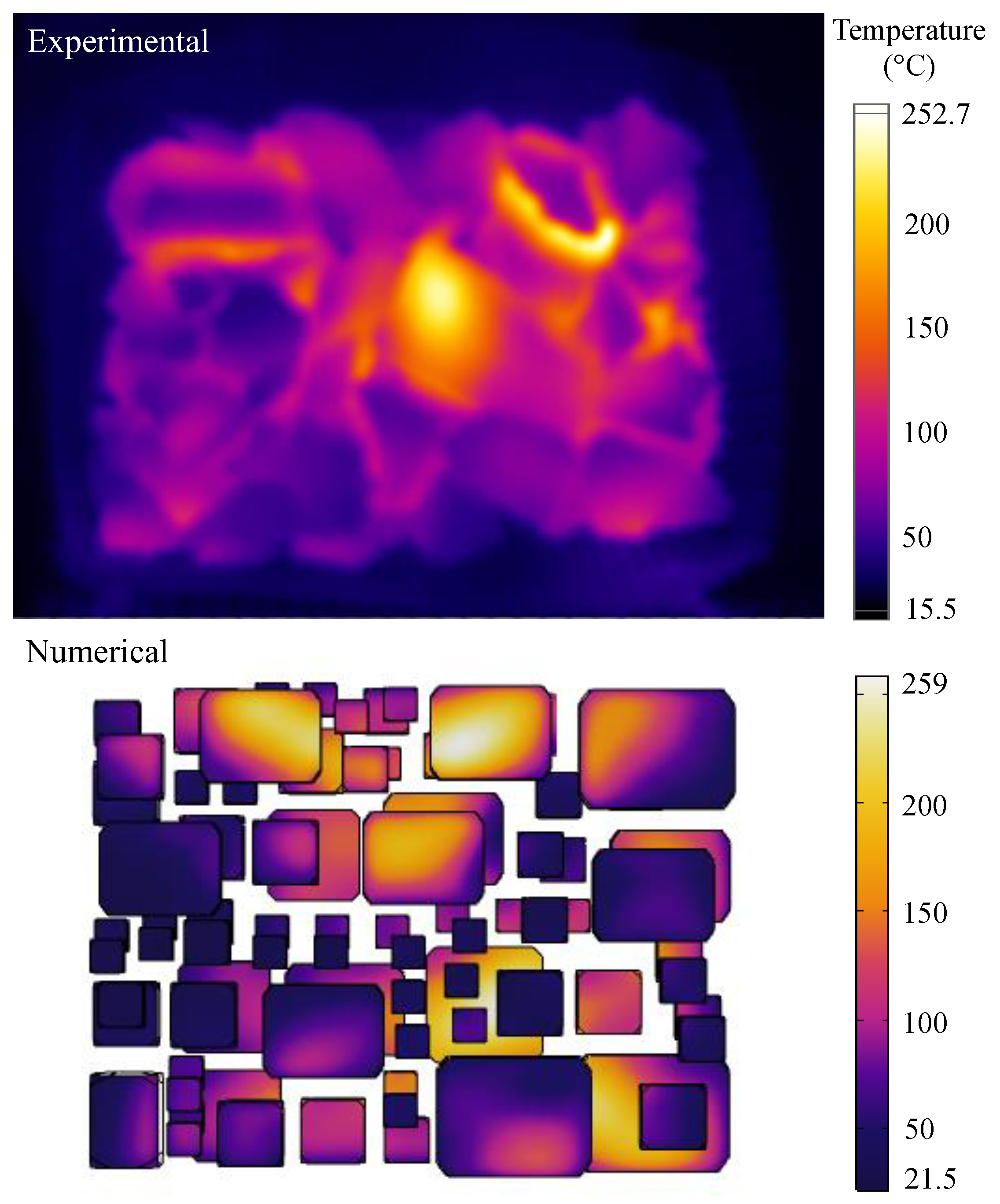


| Size Fraction (mm) | Weight (wt.%) | |||
|---|---|---|---|---|
| Sample 1 | Sample 2 | Sample 3 | Sample 4 | |
| −31.5 +26.5 | 20.82 | 20.45 | 20.58 | 20.49 |
| −26.5 +19.0 | 34.19 | 34.99 | 34.70 | 34.45 |
| −19.0 +12.5 | 26.36 | 26.12 | 26.09 | 26.40 |
| −12.5 +9.5 | 10.26 | 10.26 | 10.19 | 10.30 |
| −9.5 +6.7 | 8.37 | 8.18 | 8.44 | 8.36 |
| Diameter (mm) | Length (mm) | Mass (g) | Room Temperature Density (g/cc) | |
|---|---|---|---|---|
| Initial values | 3.23 ± 0.05 | 12.69 ± 0.10 | 0.299 ± 0.002 | 2.88 ± 0.10 |
| Final values | 3.23 ± 0.05 | 12.66 ± 0.10 | 0.296 ± 0.002 | 2.85 ± 0.10 |
| Property | Value |
|---|---|
| Thermal conductivity, [W/m °C] | 1.59 |
| Density, [kg/m3] | 2870 |
| Heat capacity, [J/kg °C] | 798 |
| Relative permeability, [1] | 1 |
| Electrical conductivity, [S/m] | 0.00005 |
| Mesh Size (mm) | Resistive Loss (W) |
|---|---|
| 0.88 | 8850.3 |
| 0.53 | 11,325.3 |
| 0.34 | 10,785.2 |
| 0.25 | 10,908.9 |
| 0.22 | 11,015.7 |
| 0.17 | 10,503.4 |
Disclaimer/Publisher’s Note: The statements, opinions and data contained in all publications are solely those of the individual author(s) and contributor(s) and not of MDPI and/or the editor(s). MDPI and/or the editor(s) disclaim responsibility for any injury to people or property resulting from any ideas, methods, instructions or products referred to in the content. |
© 2023 by the authors. Licensee MDPI, Basel, Switzerland. This article is an open access article distributed under the terms and conditions of the Creative Commons Attribution (CC BY) license (https://creativecommons.org/licenses/by/4.0/).
Share and Cite
Shadi, A.; Samea, P.; Rabiei, M.; Ghoreishi-Madiseh, S.A. Energy Efficiency of Microwave-Induced Heating of Crushed Rocks/Ores. Minerals 2023, 13, 924. https://doi.org/10.3390/min13070924
Shadi A, Samea P, Rabiei M, Ghoreishi-Madiseh SA. Energy Efficiency of Microwave-Induced Heating of Crushed Rocks/Ores. Minerals. 2023; 13(7):924. https://doi.org/10.3390/min13070924
Chicago/Turabian StyleShadi, Amin, Parham Samea, Mahdi Rabiei, and Seyed Ali Ghoreishi-Madiseh. 2023. "Energy Efficiency of Microwave-Induced Heating of Crushed Rocks/Ores" Minerals 13, no. 7: 924. https://doi.org/10.3390/min13070924






